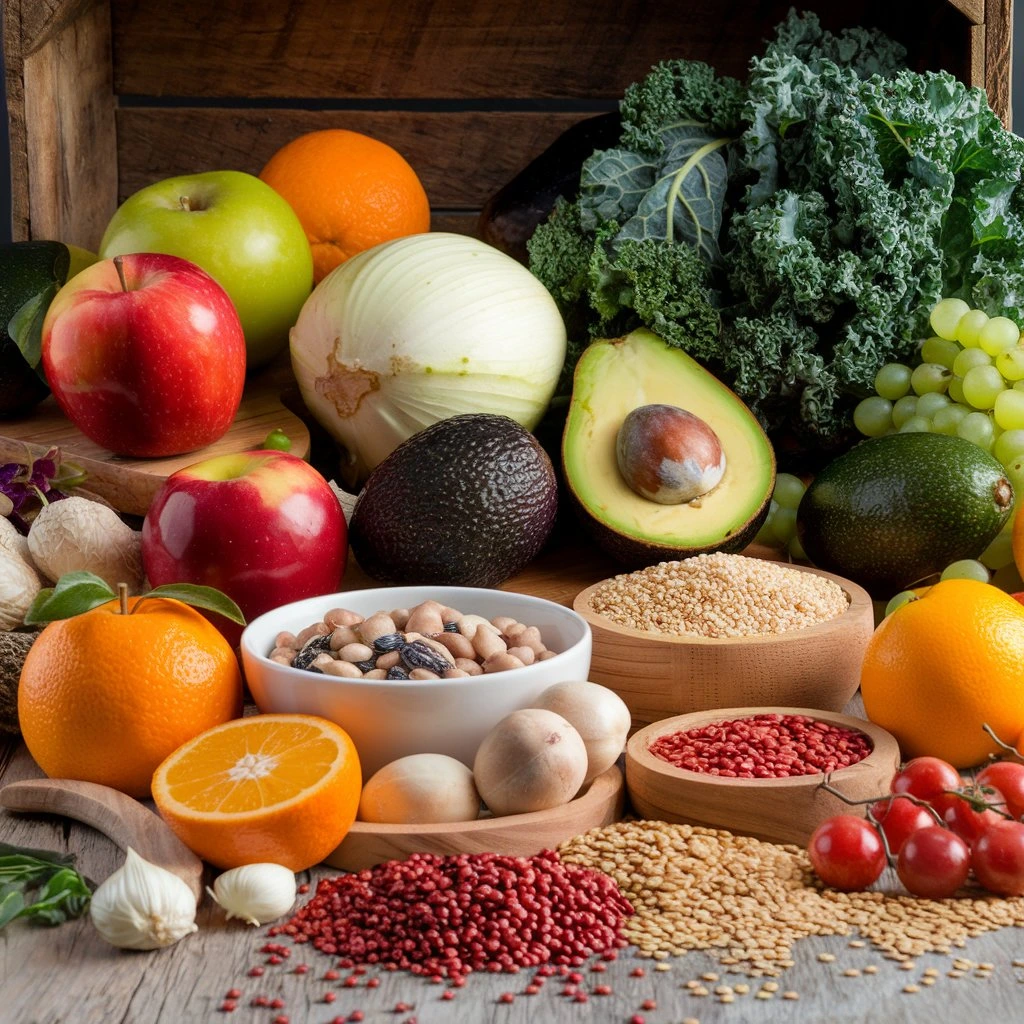Evidence-Based Whole Food Plant-Based Diet (WFPB) in South Africa

Introduction: Why This Diet Matters in South Africa
An evidence-based, whole-food, plant-based diet (WFPB) is crucial in South Africa.
Have you ever wondered if the food you eat every day could be the key to a longer, healthier life?
Chronic diseases are increasing in South Africa, just like in many other places. Heart disease, diabetes, and obesity are key concerns.
The Heart and Stroke Foundation of South Africa says that heart disease kills 225 individuals per day.
That’s a surprising number.
A whole food plant-based (WFPB) diet can help prevent and reverse many lifestyle-related diseases.
That’s the good news!
This isn’t just another diet trend. It’s a way of eating that’s backed by decades of scientific research.
And the best part? It can be done affordably and deliciously using local South African ingredients.
If you want to eat healthier on a budget and keep your favourite foods, you’re in the right place.
In this article, I’ll explain what an evidence-based WFPB diet is.
I’ll cover its health benefits, how it fits into the South African lifestyle, and provide easy steps to get started today.
What is an Evidence-Based Whole Food Plant-Based Diet?
Let’s break it down:
- Whole Foods: This involves selecting foods that are as close to their natural state as possible or that have been processed minimally. Think fresh vegetables, fruits, legumes, whole grains, nuts, and seeds.
- Plant-Based: The focus is on plant foods as the foundation of your diet, while animal products (meat, dairy, eggs) are minimised or avoided.
- Evidence-Based: This is not guesswork or internet hype. It’s a way of eating supported by scientific research, recommended by top nutrition experts worldwide.
How is WFPB Different from Vegan or Vegetarian?
Good question! A vegan diet excludes all animal products, but that doesn’t necessarily mean it’s beneficial for you.
A vegan could live on chips, soda, and highly processed fake meats.
A WFPB diet, however, emphasises whole, nutrient-dense foods.
So, potato chips might be vegan, but they’re not whole food plant-based.
The Science Behind WFPB in South Africa: Why It Works
So, why all the buzz about WFPB?
Research shows it’s one of the best ways to boost health and lower disease risk.
1. Heart Health
A significant benefit of a WFPB diet is that it can help decrease cholesterol, blood pressure, and the risk of heart disease.
The Ornish Program for Reversing Heart Disease demonstrates that adopting a plant-based diet can halt and even reverse plaque buildup in arteries.
2. Diabetes Prevention and Management
South Africa has a severe diabetes crisis.
About 4.5 million adults have this condition.
A WFPB diet is high in fibre and low in saturated fats. This helps stabilise blood sugar and boosts insulin sensitivity.
Research in Diabetes Care shows that plant-based diets lower the risk of type 2 diabetes.
3. Weight Loss and Maintenance
If you’ve been struggling to shed extra kilos, this is good news.
WFPB diets are low in calorie density and high in fibre. This helps you feel full without overeating. And you don’t have to count calories—eat wholesome foods until satisfied.
4. Lower Risk of Cancer
The World Cancer Research Fund recommends mainly eating plant foods to lower cancer risk. Antioxidants, phytochemicals, and fibre found in plants help protect against cellular damage.
Why WFPB is Perfect for South Africans
You might be thinking, “But can this work with our local lifestyle and foods?”
Absolutely! In fact, many traditional South African meals already align with WFPB principles.
Consider umngqusho (samp and beans), morogo (wild spinach), and pumpkin stew.
They are all plant-based, cheap, and healthy.
Addressing Local Health Challenges
- Obesity: Nearly 70% of South African women and 31% of men are overweight or obese. A WFPB diet helps combat this without resorting to fad diets.
- Diabetes & Hypertension: Both conditions are heavily influenced by diet. A WFPB approach naturally reduces salt and fat intake.
- Budget Concerns: Plant-based eating can save money. Use local staples like beans, maize meal, and seasonal veggies.
Local WFPB Staples You Already Know
Here’s the best part: you don’t need imported “superfoods” or expensive health store products. Your pantry probably already has some WFPB-friendly items.
Grains and Starches
- Maize meal (skip the margarine and meat)
- Sorghum (mabele porridge)
- Millet
- Brown rice
- Oats
Legumes
- Sugar beans
- Cowpeas
- Lentils
- Chickpeas

Vegetables
- Spinach and morogo.
- Pumpkin and butternut.
- Sweet potatoes
- Cabbage
- Carrots
- Green beans
Fruits
- Mangoes
- Bananas
- Apples
- Oranges
- Papayas
Nuts and Seeds
- Groundnuts
- Sunflower seeds
- Sesame seeds

Pro Tip: Check out local markets instead of big supermarkets. They’re usually cheaper and fresher.
How to Start a Whole Food Plant-Based (WFPB) Diet in South Africa
Transitioning to a new way of eating can feel overwhelming, but it doesn’t have to be. Here’s a simple roadmap:
Step 1: Start Adding, Not Subtracting
Don’t cut out everything at once. Instead, try to add more plant-based items to your meals.
Have extra veggies at lunch, or add beans to your stew.
Step 2: Make Simple Swaps
- Replace white bread with whole-grain bread.
- Swap processed meats for beans or lentils in curries.
- Use water or vegetable broth instead of oil for cooking.
Step 3: Plan Your Meals
Meal planning helps you avoid the stress of wondering, “What’s for dinner?” Cook in batches—think large pots of beans, soups, and curries that last for days.
Sample 1-Day WFPB Meal Plan (South African Style)
Here’s how a typical day could look:
Breakfast: Oats cooked with water, topped with sliced bananas, a sprinkle of cinnamon, and a spoon of peanut butter.
Mid-Morning Snack: Fresh fruit like an apple or orange, and a handful of nuts.
Lunch: Samp and beans (umngqusho) with morogo and tomato relish.
Snack: Sweet potato wedges roasted without oil.
Dinner: Lentil curry with brown rice and steaming mixed vegetables on the side.
Common Myths About WFPB
“It’s too expensive!”
Not true if you stick to whole foods. Beans, grains, and seasonal vegetables are some of the most affordable foods available.
“I won’t get enough protein.”
Nuts, seeds, beans, lentils, and chickpeas are all excellent sources of protein. Even leafy greens contain protein.
“It’s not culturally practical.”
Many South African dishes are naturally plant-based. It’s more about making minor adjustments, such as reducing oil and omitting meat in certain meals.
Frequently Asked Questions
Do I need supplements on WFPB?
The only essential supplement is Vitamin B12, which isn’t found in plant foods. Everything else can be obtained from a balanced WFPB diet.
Can kids and families follow WFPB?
Yes! Children can thrive on a plant-based diet as long as their meals are well-balanced and include a variety of foods.
Will I lose weight automatically?
Most people do because WFPB foods are naturally low in calories but high in nutrients. However, portion sizes and activity levels still matter.
Conclusion
The evidence is clear: a whole-food, plant-based diet is a strong tool. It helps prevent disease, boost health, and promote a longer life. And the best part?
You don’t need expensive superfoods or a large budget. Use local, wholesome ingredients and get creative.
If you’re ready to make a change, start with small steps. Add one plant-based meal a day, then build from there. Your health is worth it.
Let’s make plant-based eating a lifestyle, not a trend—because your future self will thank you.
